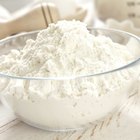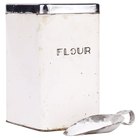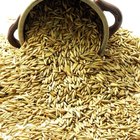unalozmen/iStock/GettyImages
While flour may seem like one of those pantry staples that keeps well indefinitely, that's not entirely true. Flour can get rancid over time, and some types of flour go bad faster than others due to natural oil content. Even worse than rancidity are weevils, those pesky pantry pests that seem to love getting into stored flour. Keep your flour at its best, long-term, by storing it in an airtight container in the refrigerator or freezer.
Pitch the Paper Sack
The original paper sacks that many brands use to package flour may seem durable enough for storage, but they're not the best vessel for keeping flour fresh, especially after you've opened it. Paper packaging is also susceptible to bug infestations when the flour is stored at room temperature. Once you've opened the flour, transfer it to an airtight container with a secure lid if you plan to keep it at room temperature. Large mason jars or thick plastic containers help keep the pests away. Label the outside of the container, along with the date of flour purchase or a "use by" date, to help remind you of both the flour type and its age.
Refined Flours
Refined flours are all the most common, all-around useful flours found in just about every grocery store. These include all-purpose flour, bread or pastry flour and self-rising flour. Refined flours store better than other varieties and don't require refrigeration or freezing, though that helps extend the flours' shelf life. Kept in a cool, dry place in an airtight container, refined flour lasts up to 2 years.
Whole-Grain and Alternative Flours
Any variety of flour that has the words "whole grain" on it offers more nutritional value than its refined counterpart, but it won't keep quite as long because it still contains the germ found in the seed used to create the flour. The oils from the germ and grain make the flour go rancid more quickly than with a similar refined flour variety; the same holds true for nut and alternative flours such as hemp, flaxseed or rice bran. Whole-grain flours include buckwheat, spelt, amaranth, rye, oat flour and just about any other specialty grain ground into flour form. To store any of these, place the flour in an airtight, insect-proof container after you've opened the original packaging. Whole-grain and alternative flours keep for up to three months in a cool, dry place such as a pantry, or about six months in a refrigerator or freezer. Nut flours should be stored at least in the refrigerator, and they can be kept, frozen, up to a year before they go bad. Read the package for specific use-by information, as the shelf-life recommendations may vary by brand or type of flour.
How to Tell When Flour Is Bad
rancid flour, or flour that's gone bad, smells different than fresh flour. If the flour smells musty, oily, sour, bitter or otherwise not quite right, pitch it. Likewise, if you see evidence of insects once you've scooped some of the flour out of its package, throw it away immediately.
Related Articles

How to Store Flour

Does Flour Get Old or Go Bad?

Does Flour Expire?

Does it Help to Keep Flour in the ...

If Flour Has Never Been Opened Can It ...

Does Flour Spoil?

Can You Use Musty Smelling Flour?

How to Store Flours & Grains Without ...

Differences Between Bleached Flour & ...

Psyllium Husk & Gluten

Substitute for Gram or Besan Flour
How Long Can Flour Be Stored in Mylar ...

How to Store Oat Bran

How Do Different Types of Flour Affect ...

How to Roast Chickpea Flour

What Is Stone-Ground Wheat?

What Additives Are in Flour?

What Is Amaranth Flour?

Is Soy Flour Healthy?

How Do You Keep Bugs Out of Baking ...
References
Writer Bio
Kathy Adams is an award-winning journalist. She is an avid DIYer that is equally at home repurposing random objects into new, useful creations as she is at supporting community gardening efforts and writing about healthy alternatives to household chemicals. She's written numerous DIY articles for paint and decor companies, as well as for Black + Decker, Hunker, Kroger, SFGate and others.